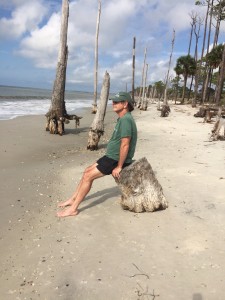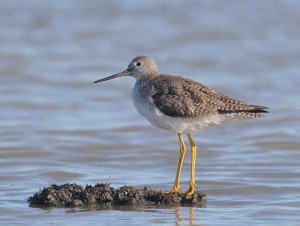 “I keep vigil…. For those who suffer, and for those who keep vigil.”*
“I keep vigil…. For those who suffer, and for those who keep vigil.”*
This was my unexpected assignment on Saturday, as Jeff and I walked a remote outer stretch of St. Vincent Island.
I came upon a red knot hunkered down at the water’s edge, a bundle of feathers pressed against the sand. We’d been admiring the knots as they moved through north Florida on their migration, 5 to 10 at a time, mostly. They feed voraciously, plunging their bills over and over into the wet sand at the water’s edge. They remind me of a host of paper doll birds, so alike is one to the next. But this one had been short stopped in her unimaginably long migration from the high Arctic to the tip of South America. This bird wasn’t going to make it.
Her eyes slitted shut, and her bill opened and closed rhythmically. I crouched at a distance that wouldn’t add to her distress, as she sipped the last air she would ever inhale. Now and again she trembled.
But she was not dying alone.
A sanderling, feisty loner of the winter beach, nestled down in the sand near the knot’s head. I’d never seen a sanderling assume such a position, though surely they do when they incubate their own eggs. Then a second red knot took up a post at the rear flank of the downed bird. Two lesser yellowlegs (tall shorebirds unusual on this beach) moved in, intervening between the small sheeting waves of the Gulf, and the knot. They tilted their heads sideways, ascertaining the knot’s situation, and then simply stood close.
The four vigil birds–only one a conspecific–were companioning the rare bird, as she died.
My human mind ran through its tricks. First, as a citizen scientist, I thought I should look for identifying color flags or bands, because the knots are so highly endangered. But I was not going to pick up this bird during her death. That would be extraordinarily disrespectful. Then I wondered for just a moment if we should try to take the bird to a wildlife rehabilitator. Considering the 8 bumpy miles we had to travel by boat when we returned to the ramp, and then who knows how far by car to find help–that trauma was out of the question, as well.
The four vigil birds showed me what to do: simply be with. Simply offer tender presence to the incapacitated one.
The sun glimmered on the yolky limbs of the yellowlegs. The wind lifted the delicately barred back feathers of the downed knot. The tide continued its rise. We all continued to breathe.
In our culture, except for domestic pets, we rarely think of animals as having complex emotional states. And we don’t often attribute them with interspecific compassion.
Ah, but we are so wrong. I saw this hospice for myself.
*This is a line from Leaning into the Darkness, written by Velma Frye and Macrina Wiederkehr. You can hear the whole amazing song on Velma’s Take Heart CD.
Share On:


As always, Sue, thank you for your lovely reflection. When we buried my old Barn Owl, our dog just sat looking at her grave for the longest time. Nothing could entice her to come inside.
I am sitting on the bayside at St. Joseph Peninsula right now. Scores of fish, killed by red tide, cover the sand at the water’s edge. Dozens of Pelicans are floating on the bay, just resting; none are fishing. I’m wondering if the Pelicans “know” these fish could make them sick.
Or Sandy, they could be sick themselves….I’ve seen vultures and oystercatchers dying after/during a red tide….
Incredible post, Sue. They are us and we are them in some ways. xxx
Wonderful perspective Susan. Thanks for sharing.
It’s so true, Mary Jane….
I’m just lucky enough to be out there where it’s all happening, John!
Once again your words have carried me away to a place where life is reverent and peaceful. Thank you for always putting things into perspective for us. What a gift it must have been to be called to share in this special experience.
How very touching. Thank you.
I am sitting at the keyboard, tingling all over from reading this post. You consistently bring your readers so many meaningful gifts: your incredible powers of observation; your knowledge of all things natural; your sensitivity in connecting your observations and experiences in intricate, multi-level, philosophical, and important ways; and, most importantly for us, your fabulous ability to pull all of this together in readable, moving, and inspiring words. Thank you, thank you!
What a wonderful observation Susan, thank you for sharing your special experience.
Thank you for the news Miss Blues!
Sue, the longer I live the more I realize they taught us the wrong lessons in wildlife school curricula (even at the graduate level). Anthropomorphism (“Bambi syndrome” that assigns human characteristics to other animals) is actually something we should look at again….and maybe humans don’t own the characteristics we’re talking about after all…
What a fascinating post. Lots to think about.
Extremely beautiful and perceptive! Thank you for observing and being with…it’s all too easy to miss those inter-relations, the bird sounds around a recently downed bird, the watchfulness in the wake of some unfortunate event.
It is so pertinent for YOU to witness this. Your observations bring me in touch with what I have observed in crows, vultures and cardinals yet the cross species vigil you describe gives my heart anew warmth. And I just finished listening to Otis Redding’s Try a Little Tenderness. Smiling and grateful to you.
I learned something about ants when I came home to my little house in Apalachicola after a trip to South Alabama. My cereal boxes were covered in ants. I shook the boxes over the sink until there were hundreds of ants in the sink. I washed many down the drain and the rest I killed with my fingers. When the sink was littered with dead ant bodies I went to bed, angry that the ants would invade my house.
The next morning the ant bodies were being removed. They were being carried away by ants. I stood and watched as the little creatures carried off their dead. When the sink was empty, I started the coffee perking and poured cereal from one of the boxes. There were no ants in the boxes. No ants came as long as I lived in that house.
I purely love you, Susan Cerulean.
thanks Susan for this wonderful insight. I so enjoy reading your work.
there is so much we don’t know about interspecies communication of our wild critters. such a tender, sacred vigil. thank you for being there to remind the wild ones that humans can be respectful, too. and for sharing your observations and experiences with us so eloquently.
So beautiful, this intimate moment you shared with the birds, and then shared with us. Thank you for reminding us of our interconnectedness with all things of this earth.
I cried
Thank you, my friends, for your kind, kind reflections. What great good fortune I feel when I am able to be out on the edge, and know that you are with me, in all your loving spirits. Isn’t it interesting, how our own pets bring us into the mystery, as well. I miss my cat so much when I am out here. Thank you, Micki, for tending him!
Your tender words and compassionate heart are balm to my heart that grieves over the harshness of humans toward the natural world.
As a naturalist I have witnessed both birds and animals gathering together when one is dying. I have also been asked to witness many times a mother bird’s loss of her chicks like the robin that nested on a log of my cabin. Nature is always trying to communicate with us and examples of this empathy are everywhere if we are present for those around us.
Thank you
Sara
This is a lesson we need to learn – the role of sitting with someone dying – “sitting bedside” for us. Wouldn’t it be wonderful if everyone had this gift of friends?
What a moving testimony to the life force that connects all,
I save this for the day I must sit in hospice with my husband Roger. Thank you, Susan, for the four vigils.